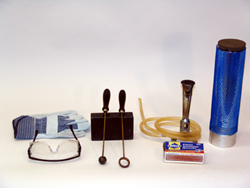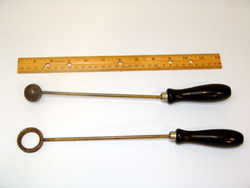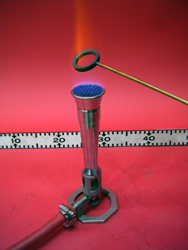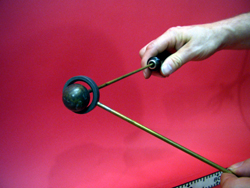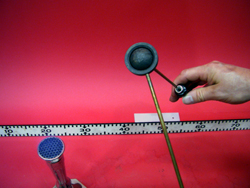|
Size: 2266
Comment:
|
← Revision 32 as of 2013-07-17 17:57:37 ⇥
Size: 4270
Comment:
|
| Deletions are marked like this. | Additions are marked like this. |
| Line 2: | Line 2: |
| ||<:30%>[[PiraScheme#Thermodynamics| Table of Thermodynamics Demonstration]]||<:30%>[[TDEquipmentList| Thermodynamics Equipment List]]||<:30%>[[Demonstrations|Lecture Demonstrations]]|| |
|
| Line 3: | Line 5: |
'''Topic and Concept:''' Thermal Properties of Matter, [[ThermalProperties#SolidExpansion| 4A30. Solid Expansion]] |
|
| Line 9: | Line 15: |
| attachment:4A30-21_01.jpg | {{attachment:4A30-21_01.jpg}} |
| Line 13: | Line 19: |
| Two set of a brass ring and a brass ball. | Two sets of a brass ring and a brass ball. |
| Line 17: | Line 23: |
| ||Two set of a ring and a ball||[:ThermoCabinetBayA3: TD, A3, Shelf #1]||<:> 4A30.21 || | ||Two sets of a ring and a ball||[[ThermoCabinetBayA3| TD, A3, Shelf #1]]||<:> 4A30.21 || |
| Line 21: | Line 27: |
| ||[[RedWhiteGasCart| Red and white gas carts]]||Rooms 2103, 2241, (and 2223 upon request) || || | |
| Line 22: | Line 29: |
| '''Setup:''' | '''Important Setup Notes:''' * This demonstration requires a supply of methane gas usually provided by the [[RedWhiteGasCart| red and white gas carts]] found in rooms 2103, 2241, (and 2223 upon request). * This demonstration requires a supply of liquid nitrogen. The main supply is located at the loading dock. If 12 hours notice given to lecture demo, supply will be provided. |
| Line 24: | Line 33: |
| 1. Make sure that you have all of the apparatuses in table above. 1. Install the burner with the gas source. 1. Heat the ball from the set that a ball can get through a ring, then show that the ball cannot get through the ring. 1. Put the ring from the set that a ball cannot get through a ring on the liquid nitrogen holder, then show that the ball can get through the ring. |
'''Setup and Procedure:''' 1. To light the burner, connect the attached gas hose to the gas out (red panel) on the [[RedWhiteGasCart|red and white gas cart]]. 1. Open the gas valve. 1. Light a match and bring it near the top of the burner. 1. The flame will ignite the gas. Adjust the flame height accordingly by adjusting the valve. Option A. Shrinking and expanding the ball 1. Show that the ball can get through the hole. 1. Heat the ball with the burner and show that the ball can no longer fit through the ring. 1. Soak the ball in the liquid nitrogen and show that it can fit through the ring again. Option B. Shrinking and expanding the ring 1. Show that the ball can get through the hole. 1. Soak the ring in the liquid nitrogen and show that the ball can no longer fit through the ring. 1. Heat the ring with the burner and show that the ball can fit through the ring again. |
| Line 30: | Line 55: |
| 1. Wear the safety glove and glasses. 1. Beware of the heated ring and the cooled ring. |
* Always use the gloves and safety glasses throughout this demonstration. * Beware of the heated plate - contact with skin could cause severe burns! * Use care when working with the liquid nitrogen - prolonged contact with skin causes severe frostbite! |
| Line 34: | Line 60: |
| '''Demonstration:''' | '''Discussion:''' |
| Line 36: | Line 62: |
| The extended ball demonstrates the thermal expansion property of the material. And the shrink ring demonstrates the opposite effect of thermal expansion property. You can show the students two ways. | When the ring or ball is heated, the dimensions of the ring or ball increase while maintaining their relative proportions. Heating causes the molecular bonds to lengthen, which causes the materials to expand. For the ring, you can think about it this way: a group of people standing in a tight circle with elbows linked try to lengthen their "bonds" by moving to hold hands at arms length. They have to expand the circle by standing back everyone stands further apart. This is analogous to the molecular bonds in the ring. This is considered a 2D expansion (the ring thickness is quite thin relative to the other dimensions) and can be described by |
| Line 38: | Line 64: |
| 1 : Extended ball | ΔA/A = α,,A,,*ΔT = α,,L,,^2^*ΔT |
| Line 40: | Line 66: |
| 1. First demonstrate to student that the ball is smaller than the ring. So, it can get through the ring. 1. Heat the ball until it expands. Demonstrate to student, this time the ball is larger than the ring. So, it cannot get through the ring. 2 : Shrink ring 1. First demonstrate to student that the ring is larger than the ball. So, the ball can get through the ring. 1. Put the ring in the liquid nitrogen until you are sure that it shrinks. Demonstrate to student, this time the ring is smaller than the ball. So, it cannot get through the ring. |
where A is the area at temperature T,,i,,, ΔA is the change in area when the material is at temperature T,,f,,, ΔT is T,,f,, - T,,i,,, and α is the coefficient of thermal expansion which depends on the material. The expansion of the ball is also 2D since the quantity of importance is the cross sectional area. See references below for more information. |
| Line 49: | Line 69: |
| ||attachment:4A30-21_01a.jpg||attachment:4A30-21_02a.jpg|| ||attachment other photos||attachment other photos|| |
||{{attachment:4A30-21_01a.jpg}}||{{attachment:4A30-21_02a.jpg}}||{{attachment:BallRing03-250.jpg}}||{{attachment:BallRing04-250.jpg}}|| ||{{attachment:BallRing05-250.jpg}}||{{attachment:BallRing06-250.jpg}}||{{attachment:BallRing07-250.jpg}}||{{attachment:BallRing08-250.jpg}}|| |
| Line 54: | Line 75: |
| 1. List any references | * [[https://en.wikipedia.org/wiki/Thermal_expansion|Wikipedia - Thermal Expansion]] * [[http://en.wikipedia.org/wiki/Coefficient_of_thermal_expansion|Wikipedia - Coefficient of Thermal Expansion]] |
| Line 56: | Line 78: |
| [:ThermalProperties:Thermal Properties of Matter] [:Demonstrations:Demonstrations] [:Instructional:Home] |
[[Instructional|Home]] |
Ball and Ring, 4A30.21
Topic and Concept:
Thermal Properties of Matter, 4A30. Solid Expansion
Location:
Cabinet: Thermodynamics Cabinet
Bay: (A3)
Shelf: #1
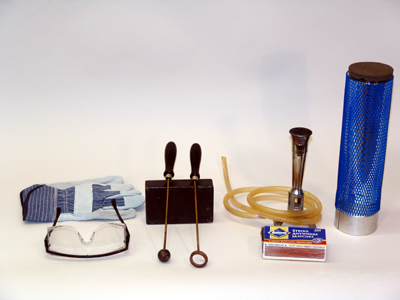
Description:
Two sets of a brass ring and a brass ball.
Equipment |
Location |
ID Number |
|
|
|
Two sets of a ring and a ball |
4A30.21 |
|
Burner |
location |
NA |
Liquid nitrogen |
location |
NA |
Safety glove and glasses |
location |
NA |
Rooms 2103, 2241, (and 2223 upon request) |
|
Important Setup Notes:
This demonstration requires a supply of methane gas usually provided by the red and white gas carts found in rooms 2103, 2241, (and 2223 upon request).
- This demonstration requires a supply of liquid nitrogen. The main supply is located at the loading dock. If 12 hours notice given to lecture demo, supply will be provided.
Setup and Procedure:
To light the burner, connect the attached gas hose to the gas out (red panel) on the red and white gas cart.
- Open the gas valve.
- Light a match and bring it near the top of the burner.
- The flame will ignite the gas. Adjust the flame height accordingly by adjusting the valve.
Option A. Shrinking and expanding the ball
- Show that the ball can get through the hole.
- Heat the ball with the burner and show that the ball can no longer fit through the ring.
- Soak the ball in the liquid nitrogen and show that it can fit through the ring again.
Option B. Shrinking and expanding the ring
- Show that the ball can get through the hole.
- Soak the ring in the liquid nitrogen and show that the ball can no longer fit through the ring.
- Heat the ring with the burner and show that the ball can fit through the ring again.
Cautions, Warnings, or Safety Concerns:
- Always use the gloves and safety glasses throughout this demonstration.
- Beware of the heated plate - contact with skin could cause severe burns!
- Use care when working with the liquid nitrogen - prolonged contact with skin causes severe frostbite!
Discussion:
When the ring or ball is heated, the dimensions of the ring or ball increase while maintaining their relative proportions. Heating causes the molecular bonds to lengthen, which causes the materials to expand. For the ring, you can think about it this way: a group of people standing in a tight circle with elbows linked try to lengthen their "bonds" by moving to hold hands at arms length. They have to expand the circle by standing back everyone stands further apart. This is analogous to the molecular bonds in the ring. This is considered a 2D expansion (the ring thickness is quite thin relative to the other dimensions) and can be described by
ΔA/A = αA*ΔT = αL2*ΔT
where A is the area at temperature Ti, ΔA is the change in area when the material is at temperature Tf, ΔT is Tf - Ti, and α is the coefficient of thermal expansion which depends on the material. The expansion of the ball is also 2D since the quantity of importance is the cross sectional area. See references below for more information.
|
|
|
|
|
|
|
|
References:
